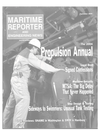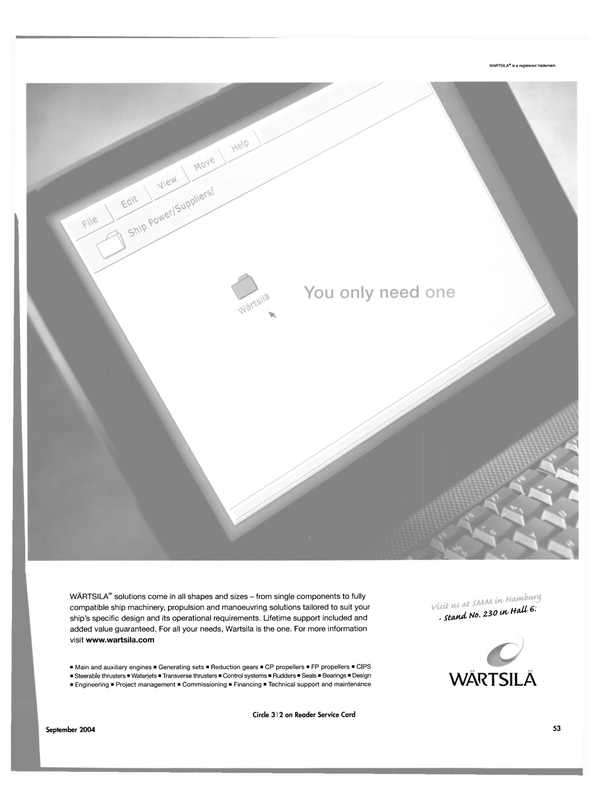
Most Powerful Common- Rail Engine Passes Test
The first 12-cylinder Sulzer RTflex96C low-speed marine engine developed by Wartsila Corporation has successfully completed its official shop test.
With a maximum continuous power output of 68,640 kW (93,360 bhp) at 102 rpm, it is reported to be the most powerful engine so far to employ common-rail technology. The engine is one of four ordered in 2003 for the propulsion of four 7,700 TEU Post-Panamax container liners contracted by Blue Star Reederei, a subsidiary of P&O Nedlloyd BV, with the Japanese shipbuilding group IHI Marine United Inc.
After the initial adjustments and running- in, the engine has been subjected to an extensive series of tests.
Optimization of the Sulzer RT-fiex system with this size of engine was completed with an eight-cylinder Sulzer RTflex96C during March/April at another licensee HSD Engine Co. Ltd. in Korea.
Further tests, however, have been made with the 12-cylinder engine into the performance of the engine with its common- rail systems.
The improved quality of combustion achieved in RT-flex engines which allows such low, stable speeds, together with smokeless operation across the speed range, has proved in service to leave RT-fiex engines very clean with consequent benefits for maintenance.
To date, confirmed orders have been placed for a total of 110 RT-flex engines aggregating 4,633 MW (6.30 million bhp). In addition to the 64 Sulzer RTflex96C engines, the engines in service and on order include seven Sulzer RTflex84T- D engines for VLCCs, two Sulzer RT-flex68T-B engines for Aframax tankers, 17 Sulzer RT-tlex60C engines and 15 Sulzer RT-flex58T-B engines for various ship types, and five Sulzer RT-flex50 engines for bulk carriers.
The Sulzer RT-flex96C is adapted from the well-established Sulzer RTA96C engine, the most powerful Sulzer low-speed marine engine type.
This is a popular prime mover for the world's largest types of container liners.
There are 226 Sulzer RTA96C and RTflex96C engines in service or on order with an aggregate power output of 13,130 MW (17.86 million bhp).
Circle 34 on Reader Service Card
Read Most Powerful Common- Rail Engine Passes Test in Pdf, Flash or Html5 edition of September 2004 Maritime Reporter
Other stories from September 2004 issue
Content
- SSI Concerns Continue page: 5
- Signed Confessions page: 9
- OMI to Pay $4.2M for Waste Oil Dumping page: 14
- NASSCO Delivers Alaskan Frontier page: 17
- Alabama Shipyard to Build Hopper Dredge page: 17
- Merwede Tapped for Navy, Commercial Contracts page: 18
- FBM Babcock Wins U.S. Contract page: 19
- New Vessels from VT Halmatic page: 19
- ABCO Launches Three New Boats page: 20
- IR Generates $64M in Orders page: 24
- Sideways to Swimmers: Unusual Tank Testing page: 26
- Current Uses of FEA in Shipbuilding page: 30
- BMT Aims to Improve Vessel Evac page: 32
- Flensburg Makes its Mark Again page: 36
- SMM 2004: Ready for the World page: 36
- German Shipyards Propose Merger page: 37
- Voith to Exhibit VWT Baut at SIMM page: 37
- Blohm + Voss Repair Wins Business page: 38
- Methane Arctic Benefits from German Technology page: 39
- Becker Kort Rudder Nozzles for Improved Maneuverability page: 40
- Payer Presented Cross of the Order of Merit page: 42
- Xantic: Focus on Integrated Solutions page: 44
- A Benchmark in Electronic Fuel Injection page: 45
- Q&A with Wartsila CTO Matti Kleimola page: 46
- Seacor Crewboats "Eliminators" Some Maintenance Costs page: 49
- (Fuel) Cells of Endeavor page: 50
- Containerships: When Will One Engine Not Be Enough? page: 52
- Most Powerful Common- Rail Engine Passes Test page: 54
- Clean Concept for Brostrom Tankers page: 54
- Canadian Towing Firm Refits for the Future page: 56
- TOR: The Next-Generation Turbocharger page: 57
- Duramax Marine Creates Largest Ever DuraCooler page: 58
- ABS: Large Ship Hull Deflections Impact the Shaft Alignment page: 60
- The Great Maritime Disruption... that Never Happened page: 66
- New Positioning Technique Helps Cut Costs in Deepwater GOM page: 76
- U.S. Ferry Market Prospects Looking Up page: 77
- "Ship Design and Construction" page: 81


